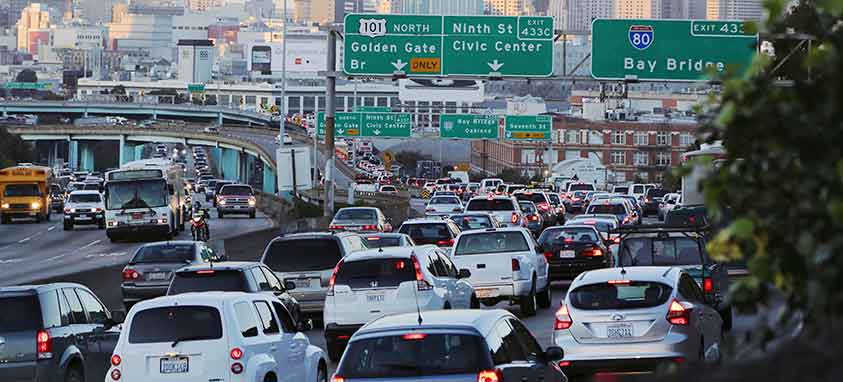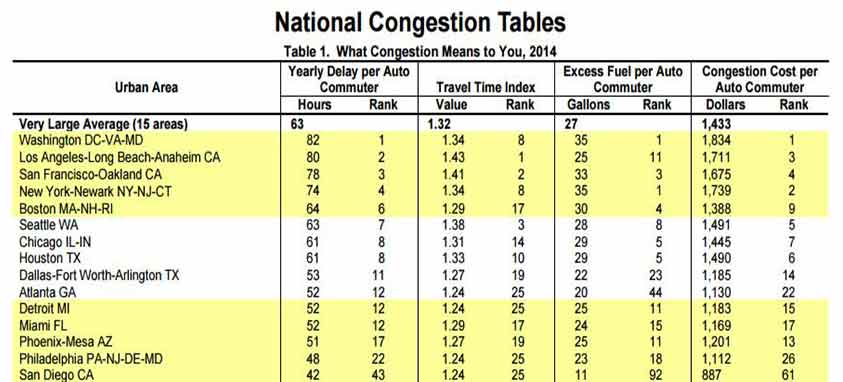Commuters may grumble about how much time they spend sitting in traffic, but which cities actually have the worst commutes in the United States? The Texas A&M Transportation Institute and INRIX crunched data from 471 urban areas in the United States to create the 2015 Urban Mobility Scorecard. Using precise methodology to create their detailed analysis, they studied nearly 900 million speed data points on 1.3 million miles of roads located throughout the U.S.
Worst Commutes in the United States
According to the report, the most congested place is Greater Washington D.C. In 2014, on top of their usual drive time, commuters in that region spent an additional 82 hours in bumper-to-bumper traffic. This cost D.C. area commuters an additional 35 gallons of fuel in 2014.
Researchers found the second most traffic-congested region in the U.S. is Greater Los Angeles, followed closely by the San Francisco Bay Area. Greater New York City came in fourth place, with the average commuter spending 74 extra hours sitting in traffic in 2014. The rest of the Top Ten, in descending order, are Greater Boston, Seattle, Chicago, Houston, Greater Dallas and Atlanta.
The Indio-Cathedral City, California area, located near Palm Springs, ranked lowest in the cities studied. There, the average commuter spent six extra hours in traffic in 2014, costing them just two additional gallons of gas.
Overall, researchers determined that the average auto commuter in the United States spent 42 extra hours stuck in traffic in 2014, up from 18 hours in 1982. In doing so, they wasted an average of 19 extra gallons of fuel in 2014, up from 4 gallons in 1982.
Collectively in 2014, drivers spent 6.9 billion extra hours idling in traffic—more than the time it would take to drive to Pluto and back if there was a road to take drivers there. From an ecological standpoint, commuters wasted an extra 3.1 billion gallons of fuel sitting in traffic last year. Financially, study authors calculated the congestion cost at $160 billion in 2014, compared to $114 billion in 2000 and $42 billion in 1982.
Why is Road Congestion Growing?
Extreme road congestion impacted 1 out of every 4 trips in 2014. Study authors blame the improved economy. During the recession of 2007 to 2010 an estimated 9 million individuals lost their jobs and essentially stopped commuting, thereby lessening road congestion. Today, the U.S. economy has regained nearly all of the lost jobs… and then some. Statistics indicate that from 2013 to 2014, more than 500,000 new jobs have been added. More workers equal more drivers on the roads, especially during peak commute hours.
The problem is compounded by the fact that the recession stalled many planned construction projects. Even if they are now greenlighted due to the economic recovery, it may be years before commuters reap results because major transit projects such as highway expansions or the development of light rail systems traditionally take a decade or two to design and fund.
Until then, study authors predict that road congestion will grow progressively worse. In 2020 they estimate that the average commuter will waste 47 additional hours and 21 extra gallons of gas. Collectively, delay will grow to 8.3 billion hours, and wasted fuel will increase to 3.8 billion gallons. They predict that the national congestion cost will grow to $192 billion in 2020.
Moving Forward
Study authors point out that immediate solutions, as well as long-term plans, are required to successfully address the problem, adding that each region must craft its own actionable mix of programs and projects.
In the short term, they recommend that employers explore ways to conduct business to avoid having workers on the road during traditional rush hours. This may translate into more flexible office hours, or providing employees with what they need to work at home for an hour or two during peak commuting times. They can also provide incentives for employees to walk, bike, take public transit or carpool to work.
They add that thanks to smartphones and specialized apps, today’s commuters have real-time traffic information available to them that can accurately predict anticipated travel times, exact locations of roadwork or crashes and transit ridership and arrival information. Such resources permit commuters to make informed decisions about departure times, the best route to take or whether it is more efficient to telecommute on a particularly bad traffic day.






